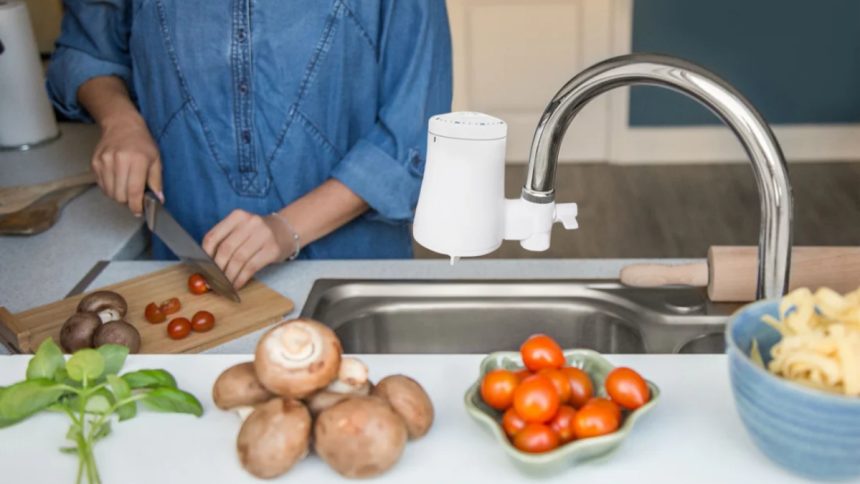Our tap water often goes unquestioned. But what truly lurks within that seemingly clear liquid? Dissolved minerals, chemicals, and even trace contaminants often hitch a ride, with potential consequences for our health, the taste of our food and drinks, and the longevity of our appliances.
Fortunately, reverse osmosis is quietly revolutionising water purity. This technology remains a mystery to many, so let’s break down its inner workings and discover how it transforms ordinary tap water into a purified, healthier alternative.
What is Reverse Osmosis?
Reverse osmosis, often abbreviated as RO, might sound fancy and complex, but it’s a remarkably simple process. Imagine a sieve with incredibly tiny holes, so small that only water molecules can pass through. This, in essence, is how reverse osmosis works.
A semipermeable membrane lies at the heart of the reverse osmosis process. This specialised filter allows only water molecules to pass through its minuscule pores. Larger contaminants like dissolved salts, heavy metals, pesticides, and even bacteria are effectively blocked, unable to navigate the membrane’s intricate structure. The result? Purified water, free from the unwanted elements that might have been present in the original source.
But why choose reverse osmosis over other filtration methods? The answer lies in its unparalleled effectiveness. Unlike simpler filters that may only remove larger particles, RO tackles a broader spectrum of contaminants, leaving behind water that’s not just clean, but truly purified. It’s a comprehensive solution for those seeking the highest quality water for their homes and families.
The Benefits of Using Reverse Osmosis Water Filters
The reasons for choosing a reverse osmosis filter are as diverse as the people who use them. Aside from the promise of cleaner water, the use of RO filters aligns with various priorities and lifestyles.
1. A Healthier Choice
For many, the health benefits of RO filtration are paramount. The ability to eliminate a broad spectrum of contaminants, from heavy metals to pesticides, offers reassurance that the water we drink is truly safe. This peace of mind, especially for families with young children or those with specific health concerns, is invaluable. It’s an investment in well-being, a proactive step towards a healthier life.
2. A Wise Investment
The financial aspect of RO filters often surprises people. While the initial cost may look a bit too steep, the long-term savings are substantial. The endless refills of purified water eliminate the need for costly bottled water purchases, and the protection RO offers to appliances can prevent expensive repairs down the line. It’s a decision that pays for itself over time, offering both financial relief and practical benefits.
3. An Eco-Conscious Choice
Those concerned about our planet’s well-being find an ally in reverse osmosis filters. It’s a conscious choice to break free from the cycle of single-use plastics, which choke our landfills and oceans. With an RO system, you’re taking a stand against the wasteful practices that harm our environment. It’s a tangible step towards a more sustainable lifestyle, one glass of clean water at a time.
How to Choose the Right RO System
Choosing the right reverse osmosis (RO) system involves navigating a few key decisions:
Types of RO Systems
Under-sink: The most common choice for homes, these systems install discreetly under your kitchen sink and provide purified water through a separate faucet. Companies such as Renewell Water are you best bet to go with.
Countertop: Portable and requiring no installation, these are perfect for apartments, RVs, or anyone wanting filtered water on demand.
Whole-house: These comprehensive systems filter all the water entering your home, ensuring purity at every tap, shower, and appliance.
Factors to Consider
Daily Water Usage: How much water does your household consume on average? This helps determine the system’s capacity.
Number of People: Larger households need systems that can handle higher demand.
Contaminants: If you know the specific impurities in your water (through testing), you can choose a system tailored to address those concerns.
Budget: RO systems range in price. Determine what you’re comfortable spending upfront and factor in long-term filter replacement costs.
Maintenance: Some systems require more frequent filter changes than others. Consider your willingness to perform regular upkeep.
Installing and Maintaining Your RO System
Turning your new reverse osmosis system from a box of parts to a source of purified water might seem daunting, but it doesn’t have to be. Your path depends on how comfortable you are with hands-on projects and the specific system you’ve chosen.
Some folks relish the challenge of a DIY installation. If you’re one of them, grab the manufacturer’s instructions and get ready to dive in. You’ll not only save some money but also gain a deeper understanding of how your system works. Just be prepared—it can take time and requires some technical know-how.
But if plumbing isn’t your forte, or if your system is particularly complex, don’t hesitate to call in the pros such as Total Drain Cleaning. Experienced technicians will handle everything, ensuring a smooth and safe setup that maximises your system’s performance. While it’s an added expense, the peace of mind knowing it’s done right can be priceless.
Regardless of who installs it, keeping your RO system in tip-top shape means regular maintenance. Filters need changing, the system needs flushing, and water pressure needs monitoring. These small tasks ensure you continue to enjoy clean, pure water for years to come.
Lynn Martelli is an editor at Readability. She received her MFA in Creative Writing from Antioch University and has worked as an editor for over 10 years. Lynn has edited a wide variety of books, including fiction, non-fiction, memoirs, and more. In her free time, Lynn enjoys reading, writing, and spending time with her family and friends.















